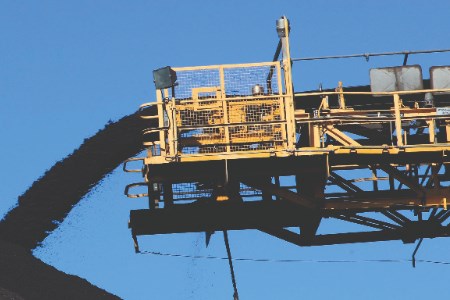
One of the most common methods to mitigate dust is to add water until the material reaches its optimum dust extinction moisture level (DEM). DEM is the scale of moisture content in the material – at which the dust number is 10 – used to determine the ideal dust/moisture relationship to control dust. This is a challenging task, particularly for coal and iron ore, which require a large amount of water to achieve the target DEM. Adding water to mined material until it reaches target DEM is currently seen as the most effective method for mitigating dust in coal and iron ore, while meeting strict dust control regulations.
However, water is usually an issue for mining, because it is a valuable resource. Moreover, constraints make wet mineral extraction impractical and unsustainable in many parts of the world.
A dichotomy is presented as large volumes of water are required to minimise dust from coal and iron ore, while excessive moisture can negatively affect the material, causing excess weight and stickiness, while failing to provide additional benefits. Benefits include the prevention of dust down the line.
While having a moisture content near the DEM is advantageous for reducing dust emissions, there is a high potential that the amount of water will affect the quality of the material and cause handling problems, not just at the mine, but throughout transportation and storage, affecting product quality for the end user.
RST Solutions suggests the best way to achieve optimal DEM is to significantly reduce the volume of water needed to attain a material’s DEM sweet spot. To achieve that, the company’s research and development team has been working on an advanced total material treatment to hold moisture in minerals and waste materials for longer periods of time, and mitigate dust without relying on excessive amounts of water.
Unique chemistry designed by RST Solutions is now in the advanced trial phase with a global coal and iron ore mine company, conducting field tests throughout its Australian operations. The goal is to achieve optimal DEM levels to suppress dust and meet strict health and environmental obligations in the most effective and economic way, while maintaining product quality for processing and manufacturing.
The challenges
Coal and iron ore mines can face challenges in achieving the mandatory DEM levels. As a result, Australian coal mines are looking at alternative methods of achieving optimal DEM instead of simply using water. It is a costly exercise and risks the material being overwatered by dust suppression activities during storage, transportation, and at transfer points.
The mines were seeking to achieve optimal DEM levels to meet dust control requirements in the most effective and economic way, while maintaining material quality along the whole supply chain until it reached the end user customer. The key for mine site operators is to gain the ability to control the moisture content in mined material, in order to manage fugitive dust lift-off without relying solely on water to do the job. RST Solutions was presented with the opportunity to develop a product with advanced fine particle chemistry in response to these unique challenges.